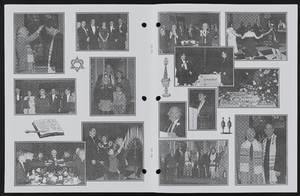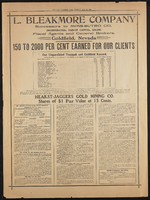Search the Special Collections and Archives Portal
Search Results
Alice P. Broudy Papers on Broudy v. United States
Identifier
Abstract
The Alice P. Broudy Papers on Broudy v United States (1940-2018) comprise materials collected and created by the wife of Charles A. Broudy during her effort to obtain compensation for his death in 1977, which she believed to be a result of repeated radiation exposure. Materials include government documents obtained through the Freedom of Information Act (FOIA), correspondence, memos, litigation papers, scholarly reports and articles on radiation exposure and its effects, congressional testimony, speeches, newspaper clippings, books and audiovisual materials. Also included are photographs, slides, and one box of Alice "Pat" Broudy's personal papers. There are two boxes of papers that remain unprocessed.
Archival Collection

Photographs of Rummel Motel sign, Las Vegas (Nev.), February 23, 2017
Date
Archival Collection
Description
Site address: 1809 S Las Vegas Blvd
Sign owner: Yeh Chia-Hong
Sign details: The motel was founded by Marvin Rummel in 1945 (VintageLasVegas, n.d.), although the Clark County Assessor lists the original construction year as 1951 (Assessor, n.d.). Undated vintage postcards, one describing the motel as "new" (Rummel Motel, 1809 So. 5th St. U.S. 91 - L.A. Highway Las Vegas, Nevada original vintage postcard, n.d.) show that a two-story building was later added to the back of the motor court (VintageLasVegas). The addition may explain the discrepancy in construction dates. The Roles family purchased the property in 1958 (VintageLasVegas; Noted bowler, hotel owner dies, 2002). Ralph Roles also operated the Del Mar Motel (the Del Mar's sign, designed by Betty Willis, is now at the Neon Museum). A vintage postcard from 1958 shows that motel was endorsed by the Automobile Association of America and another automobile club (Garofalo, 2011). The motel was severely damaged by fire on April 30 2017 (VintageLasVegas; Hershkovitz, 2017) and is currently closed.
Sign condition: The condition is 2, fair. The lower portion of the cabinet is dented and access panels are damaged or missing. The upper portions of the cabinet display numerous metal patches. The plastic on the reader board has holes. The remaining neon tubing appears to be intact. All incandescent light bulbs are missing.
Sign form: Pylon sign
Sign-specific description: The sign is supported by a rectangular blue metal pylon. A blue metal-framed reader board and orange metal upper cabinet are cantilevered out from the pylon toward the street. In the center of the upper cabinet is an amoeba-shaped area which is painted black and outlined by white skeleton neon. Inside the black amoeba are individual cursive letters which spell out "Rummel Motel" in white paint traced by white skeleton neon. Atop the upper cabinet is a smaller orange metal cabinet which is wing-shaped. Above the wing is a blue metal circle. Inside the channel of the circle are six concentric circles of empty light sockets. On the outside of the circle is a semi-circular metal frame which holds five white skeleton neon five-pointed stars.
Sign - type of display: Neon, incandescent and reader board
Sign - media: Steel and plastic
Sign - non-neon treatments: Incandescent light bulbs and a reader board
Sign environment: This is located on Las Vegas Boulevard South just north of the Las Vegas Strip
Sign - date of installation: The current sign dates back to at least 1958, but probably is not the original motel sign. A vintage postcard shows that before the two-story addition, the motel had a simple double pole sign with the name "Rummel Motel" enclosed by an open oval (Rummel Motel, 1809 So. 5th St. U.S. 91 - L.A. Highway Las Vegas, Nevada original vintage postcard, n.d.). The colors, lettering style and oval shape of the former sign appear to have inspired the design of the sign seen in a postcard from 1958 (Garofalo, 2011). The latter sign, with heavy modification, is the sign seen on the property today. The sign as currently configured is recognizable in a postcard from the late 1950's or early 1960's (Las Vegas motels then and now, n.d.).
Sign - date of redesign/move: The circa 1958 sign (Garofalo, 2011) was supported by double poles. The pole on the street side of the sign can still be seen on the upper cabinet, but it no longer reaches to the ground. The pole on the motel side of the sign ran from the ground toward the center of the sign, and then doglegged inward toward the motel to support the sign from the side. That pole appears to be the same one now enclosed by the pylon. The shadow of the pole can be seen inside the current reader board, which was a later addition attached below the circa 1958 sign. Automobile club shields at the bottom of the circa 1958 sign have been removed. A black metal directional arrow pointing toward the motel from the street side of the sign has also been removed. A circular white or light yellow metal cabinet with concentric rows of incandescent lightbulbs in the interior and a semi-circle of neon stars on the exterior has been moved from the top of the former directional arrow to the top of the wing-shaped cabinet. The circa 1958 wing-shaped cabinet was flush with the street side of the sign and contained skeleton neon which advertised, "HEATED POOL". The current wing-shaped cabinet contains no neon and has been pushed to the center of the sign. The lower cabinet of the circa 1958 sign was painted orange and black, which is now all orange. The amoeba shape was painted blue and is now black. Below the amoeba were skeleton neon letters which spelled out, "NO VACANCY" and "24 HOUR ROOM SERVICE". The neon is now gone. A small black metal cabinet attached at the bottom of the sign contained what appear to be either painted or skeleton neon letters which state, "COOLED BY REFRIGERATION". That portion of the sign is now gone.
Sign - thematic influences: This sign showcases 1950's and 1960's Googie trends. This also conveys earlier motor court designs in the building and the sign.
Survey - research locations: Clark County Assessor, Parcel No. 162-03-310-007, Retrieved from http://www.clarkcountynv.gov/assessor/Pages/PropertyRecords.aspx?H=redrock&P=assrrealprop/pcl.aspx Garofalo, M. (2011 November 2). Still standing-Rummel Motel. Retrieved from https://www.flickr.com/photos/vintageroadtrip/6304823598/ Hershkovitz, R. (2017 April 30). Fire damages vacant downtown Las Vegas motel. Las Vegas Review Journal. Retrieved from https://www.reviewjournal.com/local/local-las-vegas/downtown/fire-damages-vacant-downtown-las-vegas-motel/ Las Vegas motels-Then and now. (n.d.). Rummel Motel. Retrieved from http://stefanidrivesvegas.com/8.html Noted bowler, motel owner Roles dies. (2002 July 30). Las Vegas Sun. Retrieved from https://lasvegassun.com/news/2002/jul/30/noted-bowler-motel-owner-roles-dies/ RoadsideArchitecture. (n.d.) The Rummel Motel. Retrieved from http://www.roadarch.com/signs/nvvegas3.html Rummel Motel, 1809 So. 5th St. U.S. 91 - L.A. Highway Las Vegas, Nevada original vintage postcard. (n.d.). Retrieved from https://www.amazon.com/Rummel-Motel-1809-So-U-S/dp/B00P9LEQCS VintageLasVegas. (n.d.). Rummel Motel. Retrieved from http://vintagelasvegas.com/post/160953547509/rummel-motel-1809-s-las-vegas-blvd-built-by
Surveyor: Mitchell Cohen
Survey - date completed: 2017-09-18
Sign keywords: Pylon; Neon; Incandescent; Reader board; Plastic; Steel
Mixed Content

Transcript of interview with Arby Hambric by Claytee D. White, September 23, 2015
Date
Archival Collection
Description
Arby L. Hambric's book entitled, "To Thee I See: From picking in the fields of Texas to cooking for dignitaries on U.S. Navy ships, a journey I wouldn't change," describes his profound journey from working in the cotton fields as a child to being drafted into the U.S. Navy, before completing high school. During this interview, he recalls the significant achievements of the "Red Tails" and the Tuskegee Airmen. Beginning his 20 year Navy career before military integration, Arby describes the racial tensions that plagued the U.S. Navy in the 1940s, and discusses how he was able to successfully navigate that racist environment for two decades and three war eras. Arby enrolled in San Diego State College after leaving the U.S. Navy. He also worked as maintenance personnel for Sears and Roebuck and started a catering business with his wife. He became a member of the Southern Nevada Enterprise Community, SNEC Board upon moving to Las Vegas, Nevada, after his wife died. With a family legacy he can be proud of, Arby highlights the achievements of his great grandson Taquan Mizzell, a Virginia Cavaliers running back at the University of Virginia. As a Navy veteran, Arby often volunteered his time and resources to help others in need. He recalls driving the sick and elderly back and forth from the Westside community to Valley Hospital or University Medical Center, UMC. He also discusses government enforced road closures and a wall that was built to block Blacks from entering the new downtown. This interview sheds new light on military integration and offers key strategies for overcoming environmental racism. Arby mentions a documentary about the closing of the wall and offers his predictions on the future of the Westside.
Text

Interview with Robert Rex Brownlee, August 6, 2007
Date
Archival Collection
Description
Text
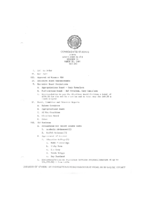
Meeting minutes for Consolidated Student Senate University of Nevada, Las Vegas, March 20, 1984
Date
Archival Collection
Description
Text
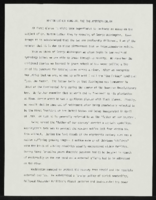
"Martin Luther King, Jr. and the American Dream": article draft by Roosevelt Fitzgerald
Date
Archival Collection
Description
From the Roosevelt Fitzgerald Professional Papers (MS-01082) -- Drafts for the Las Vegas Sentinel Voice file. On George Washington and Martin Luther King, Jr. comparisons.
Text
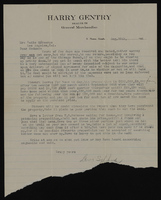
Correspondence, Levi Syphus to Sadie George
Date
Archival Collection
Description
Text

